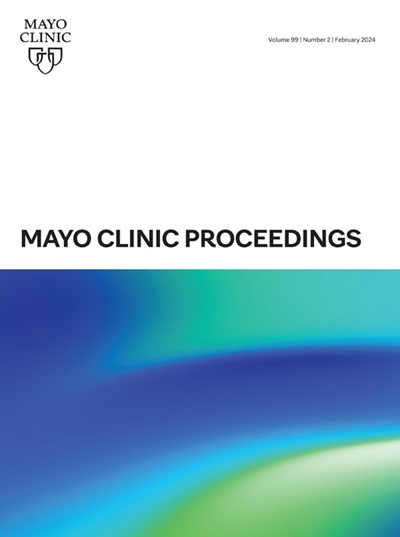健康年轻人高血压和抗高血压药物的长期预后:韩国一项基于全国人群的前瞻性队列研究
IF 6.7
2区 医学
Q1 MEDICINE, GENERAL & INTERNAL
引用次数: 0
摘要
目的:探讨高血压(HTN)和降压药物对健康青年(约20 ~ 45岁)心血管疾病发病率的影响。患者和方法:共有4,590,597名无合并症的韩国年轻人接受了定期健康检查。根据血压(BP)分为4组(最佳血压、正常血压、高正常血压和HTN)。主要结局是心肌梗死、缺血性和出血性卒中发生率的综合结果,该结果是通过跟踪第一个《国际疾病分类》第十次修订代码的医疗使用数据获得的。根据随访期间降压药处方比例将HTN组分为2个亚组进行亚组分析。结果:患者平均年龄33.8岁,中位随访时间15.9年。与最佳血压组相比,高血压使主要心血管疾病的发病率增加了2.16倍。血脂异常和HTN分别是心肌梗死和脑卒中最主要的危险因素。在亚组分析中,抗高血压药物使所有疾病的心血管疾病发生率降低了70%。结论:包括HTN在内的心血管危险因素是青壮年主要心血管疾病的发病因素。抗高血压药物降低了主要心血管疾病的发生率。本文章由计算机程序翻译,如有差异,请以英文原文为准。
Long-term Outcomes of Hypertension and Antihypertensive Drugs in Healthy Young Adults: A Nationwide Population-Based Prospective Cohort Study in Korea
Objectives
To investigate the effect of hypertension (HTN) and antihypertensive medications on the incidence of cardiovascular disease in healthy young adults (approximately 20 to 45 years).
Patients and Methods
In total, 4,590,597 young Korean adults without comorbidities who underwent regular health examinations were included in this study. They were stratified into 4 groups according to their blood pressure (BP) (optimal BP, normal BP, high normal BP, and HTN). The primary outcome was a composite of the incidence of myocardial infarction and ischemic and hemorrhagic stroke, obtained by tracking the medical use data of the first-ever International Classification of Diseases, Tenth Revision codes. Subgroup analysis was conducted by categorizing the HTN group into 2 subgroups according to the prescription ratios of the antihypertensive drugs during the follow-up period.
Results
The average age was 33.8 years, and the median follow-up duration was 15.9 years. Hypertension elevated the incidence risk of major cardiovascular disease by 2.16 times compared with that of the optimal BP group. Dyslipidemia and HTN were the most dominant risk factors for myocardial infarction and stroke, respectively. In the subgroup analysis, antihypertensive medications decreased the incidence of cardiovascular disease by 70% in all diseases.
Conclusion
Cardiovascular risk factors, including HTN, contribute to major cardiovascular disease incidence in young adults. Antihypertensive medications decreased the major cardiovascular disease incidence estimates.
求助全文
通过发布文献求助,成功后即可免费获取论文全文。
去求助
来源期刊

Mayo Clinic proceedings
医学-医学:内科
CiteScore
16.80
自引率
1.10%
发文量
383
审稿时长
37 days
期刊介绍:
Mayo Clinic Proceedings is a premier peer-reviewed clinical journal in general medicine. Sponsored by Mayo Clinic, it is one of the most widely read and highly cited scientific publications for physicians. Since 1926, Mayo Clinic Proceedings has continuously published articles that focus on clinical medicine and support the professional and educational needs of its readers. The journal welcomes submissions from authors worldwide and includes Nobel-prize-winning research in its content. With an Impact Factor of 8.9, Mayo Clinic Proceedings is ranked #20 out of 167 journals in the Medicine, General and Internal category, placing it in the top 12% of these journals. It invites manuscripts on clinical and laboratory medicine, health care policy and economics, medical education and ethics, and related topics.
 求助内容:
求助内容: 应助结果提醒方式:
应助结果提醒方式:


